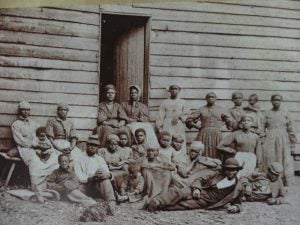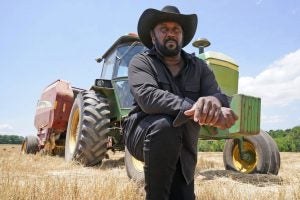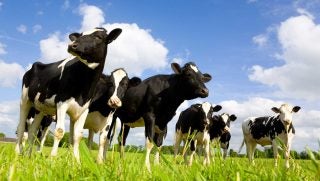Forty acres and a mule. That’s what was distributed to stolen and enslaved Black people to begin their free lives in this country after slavery.
This term “40 acres and a mule” was not invented by Black folks, but coined by us. It is a way of saying that what has been given really is nothing compared to what is deserved.
When slavery was abolished in the U.S. in 1865, Black people were given mules and 40 acres of shared crop land to start their “new lives.” However, they were also sent into a world of discrimination and hateful taunting that made farming and living life a horrid yet necessary experience.
Forty acres and a mule were not enough resources and preparation for the world of discrimination Black folks were stepping into. Yet, they made what little they received into inspiration for the generations to come. Our history and our ancestral examples have taught us to persevere and do what we can with what we have.

It was because of our ancestors’ perseverance through life’s greatest fears and challenges that Black folks are where we are today. However, today still stews in systemic discrimination and lack of follow through from our systems of support in this country.
Just because perseverance is sewn into our bloodlines does not give any entity an excuse to keep dragging Black farmers along in struggles and challenges. We need relief.
Black farmers were promised equity, in writing, through the American Rescue Plan. Their hopes for a prosperous relief package were squashed after growing, harvesting, and distributing food during the COVID-19 pandemic.
Our hearts are heavy, as the U.S. Department of Agriculture’s loan forgiveness program is now funneling Black farming families toward loss of intergenerational wealth after battling decades of discrimination while maintaining their properties and businesses.
Of course, the USDA Equity Commission gives us hope for a more sustainable future for all people of color in agriculture. The jury is out on whether or not their efforts will be successful. All we know are the commission’s draft plans for eradicating discrimination in the USDA among other conversations centering around becoming a more equitable government department.
And as I have stated in previous columns, we can talk the talk. Walking the walk is where the impact is actually seen and felt. We wait for their walk toward implementation of their desired equity practices.
National Black Farmers Association President John Boyd Jr. made this statement in 2022 during the conflict in the courts centered around relief for Black Farmers in the American Rescue Plan: “President Biden must move quickly to protect Black farmers now that he has repealed promised debt relief for Black farmers. … We have days, not weeks and months, to save Black, Native American and other farmers of color from ruin.”

The lack of follow through on the Biden Administration’s behalf from the USDA in terms of relief for Black farmers wasn’t intentional. The intention of the loan forgiveness program was there, debated, and was ready to be pushed out to Black farmers.
However, was it poorly rolled out? Was the promise to Black farmers through the American Rescue Plan too premature? Should the administration have worked closer with the USDA, aligning their rollout of their loan forgiveness program for Black farmers alongside the infrastructure of the USDA Equity Commission?
Those are the questions that I ask myself. And those are the questions I believe we should all be asking.
Following this story since the American Rescue Plans inception in March 2021, the plan has gone through many revisions. The initial loan forgiveness went from a lump some to a more agreeable amount for the bipartisan party that voted to pass the plan.
However, the loan forgiveness for Black farmers within the plan has been blocked heavily by courts across the nation. Lawsuits have been strewn about our country against this loan forgiveness for Black farmers with arguments being made that, “We [Farmers] are ALL struggling.” But then I wonder … how much do the folks who make these types of arguments and/or pursue these types of lawsuits understand the impact systemic racism and discrimination has had and still has on people of color of agriculture? And if they do understand, how much are the years of systemic racism and discrimination reparations worth to them?
I guess that is an unfair question. The only people who can really identify the worth of something so grave and deplorable as the systemic racism and discrimination Black farmers had to endure for over 100 years are Black farmers and their families. Point blank.
“Black and other farmers of color did exactly what the government asked them to do,” said Ben Crump, lead attorney for George Floyd’s family, in a statement to NEWSONE. “They maintained operations to strengthen America’s food supply during the COVID-19 crisis. They believe in the U.S. government’s promise. Instead, it was 40 acres and a mule all over again, 150 years later-broken promises …”
As our ancestors before us, we will continue to persevere. But, just as our ancestors had before us, we will continue to seek justice and reclaim what is rightfully deserving of us. In the face of scrutiny and injustice, Black farmers will not quit. Forty acres and a mule is too little and there is too much at stake.
When will farmers of color, especially our Black farmers, receive the aid they have needed for more than 100 years?
Bre Holbert is a past National FFA President and studied agriculture science and education at California State-Chico. “Two ears to listen is better than one mouth to speak. Two ears allow us to affirm more people, rather than letting our mouth loose to damage people’s story by speaking on behalf of others.”



